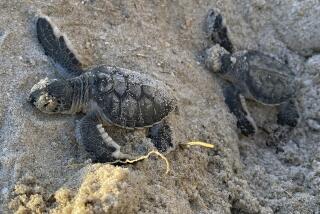Satellite Tracking Helps Keep an Eye on Florida’s Endangered Manatees
- Share via
MIAMI — James Reid is agile and quiet enough to make quick work of a wet encounter with a 3,000-pound manatee being tracked from the heavens through an electronic float attached near its tail.
Reid must regularly change battery packs on the satellite-tracking devices used to unlock some of the mysteries of a marine mammal that would like to steer clear of people in a state growing more crowded every day.
Manatee research has taken a great technological leap from a time when photos of scar tissue served as the primary means of identification. Today, satellite telemetry tracks the tagged animals from a remote lab.
From the raw satellite numbers, researchers have gleaned information about West Indian manatee travel, feeding, resting and freshwater access that can be used in behavioral studies and policy development for manatee protection.
Manatees, a lumbering relative of the elephant, resemble a toothless walrus from the front and a seal from the back. Homeliness has popularized the endangered gray-brown sea cow, which is depicted on a fund-raising Florida license plate.
But its ability to coexist with humans in boat-jammed rivers and estuaries has contributed to its downfall. Boat strikes are a leading cause of death, and only about 1,200 manatees survive in Florida waters.
In six years, the U.S. Fish and Wildlife Service has fitted 22 manatees with satellite telemetry equipment called platform transmitter terminals.
“Prior to this, we only speculated as to what manatees could do in terms of long-distance moves,” said Reid, who has worked with manatees for Fish and Wildlife since 1983.
A $4,000 floating, color-coded tracking unit is attached to a manatee above its tail with a 6-foot nylon tether. The device weighs less than 5 pounds and is visible about four inches above the waterline.
The assembly has evolved to make them easy to detach in case of accidental entanglement and to incorporate VHF transmitters and sonic alarms called “pingers” to make the floats easier to find in the wild.
Satellite tracking has helped pinpoint popular rest stops as manatees move from winter enclaves--often warm water outfalls at power plants--to their broader summer distribution. Winter herds of at least 200 are found at Ft. Myers, Riviera Beach, Port Everglades and Crystal River.
“We may find that one animal leads us to a place that is of prime importance to the population that we didn’t even know about,” said Thomas O’Shea, head of Fish and Wildlife’s manatee research program, the Sirenia Project based in Gainesville.
Manatees are known to be faithful to their geographic preferences from one year to the next, but seasonal migrations of 530 miles have been detected by the satellite, he said.
During tracking, the Tiros-N satellite data arrives at the Argos monitoring laboratory in Greenbelt, Md., as a series of numbers requiring computer translation.
The same satellite tracking gear is used in emergencies for locating airliners, on Japanese fishing vessels to make sure they respect seine fishing boundaries, and for oceanographic studies of drift currents, O’Shea said.
As high-tech as tracking has become, not all the information is reliable. The satellite makes six passes a day, and the most useful data comes from multiple signals on a manatee at rest. The best numbers can pinpoint a manatee within 50 to 100 yards.
“The numbers tell you the identification number of the tag, and the time--the hour and minute and second of the day that it occurred--and then some information about what’s going on with the animal--activity, water temperature,” said Bruce Ackerman, a state marine mammal researcher.
O’Shea and Reid are working with the state to apply the satellite data to manatee management, including speed zones for boats.
At Crystal River on the Gulf Coast, manatees are deserting some of their favorite old spots.
“Increasing recreation pressure from swimmers, divers and boaters has resulted in the animals spending more time hiding in the small sanctuaries that exist and less time in their preferred areas,” O’Shea said. “The service is trying to find a way to reduce that pressure.”
Thirteen Florida counties will have temporary management plans within a year, and 33 counties inhabited by sea cows eventually must come up with permanent protection plans.
“When you look at the endangered status of the species, you look at how integrally it’s related to growth in the state,” said Patrick Rose, the state wildlife agency’s marine mammal coordinator.
Last spring, a pregnant female traveling with a calf was tracked into the Kings Bay, Ga., submarine base when the transmitter went off the air. A tugboat operator thought he had hit something, and manatee researchers found that the missing mother manatee had been sucked through the propeller and killed.
Efforts are under way to change the propeller design.
Satellite telemetry has been applied to other wildlife, primarily in Alaska, including polar and grizzly bears, caribou and wolves. Eagles and geese also have been tracked.
“We certainly have the opportunity with manatees to gain far more information about them than we do other species,” said Scott Wright, a state manatee mortality expert. “Unlike a number of different species, whether they be terrestrial or marine, manatees represent somewhat of a unique situation in that we may be able to turn these animals around.”
More to Read
Sign up for Essential California
The most important California stories and recommendations in your inbox every morning.
You may occasionally receive promotional content from the Los Angeles Times.













